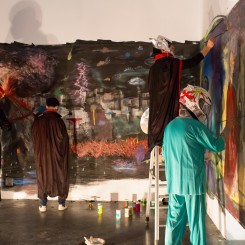IW: I wonder if anything significant has come out of it for you, thoughts it has provoked?
PT: In the beginning it was the whole notion of collaborative and collective efforts. Each collective interprets this very differently and that impression was pretty immediate. We chose the ones that are still producing works, not considering whether they were practising collectively in the sense of making one work together or in the sense of doing projects together — there was no discrimination: “If you’re still creating works, then you’re invited.” Then we see how they want to present themselves as a collective. The way they react to how the show is scheduled each week and who they’re paired with gives a sense of what they think collectivity or collaboration is about.
IW: So that is part of what audiences can get from seeing SEE/SAW?
PT: Yes. It’s very interesting — and also because an institution, by definition, is also a collective. So it’s a big collective working with smaller collectives, and how these collectives view that relationship and how they engage with us is relevant. I also want to do things that break away from institutional norms; collectives are a really good way to do that.
IW: I wondered also about these “ON | OFF” and “SEE/SAW” titles. Is there something significant for you in the idea of a see-saw?
PT: Well, the format was one of the first things that was decided. Two equal sides with something in the middle that can connect or separate them — therefore, something between the two connected rooms that form the space in which SEE/SAW is shown…. And then trying to find a good name for it. Splitting it up doesn’t mean you want to compare and contrast; keeping that hole or passage in the middle means that the passing of information should be uninhibited. But not a lot of the collectives have been using that channel yet; those who have been in there so far have effectively seen it as two separate spaces, but I hope that somebody will approach it differently. In the beginning I had fantasies about them going crazy and running between the spaces or playing games. “SEE/SAW” is supposedly more lively than stable. There is not supposed to be a winner — it’s something that’s quite back and forth, but never gets off track. That’s the idea. And then of course see-saw plays also with the act of changing the show once a week.
IW: How closely did you work with the artists in terms of what they designed for the space?
PT: I wanted to leave it in their hands by saying, “Okay, this is the idea of the show and this is what we’re going to be looking at. Please propose something.” But it was not as if I was saying, “You give me a proposal, and I say ‘yes’ or ‘no.’” It was more that I was going to say “yes” to pretty much anything they wanted to do, within the boundaries of certain rules like setting things on fire and appropriateness…. Unfortunately not all of them have been that risky. 8mg did ask me if they could take a brick out of the UCCA façade and replace it with their own. Technically, I have to say, “No, you can’t.” But I wanted to encourage them to push this boundary.
IW: Any feedback yet from the public or press?
PT: I think many people’s impression is a bit “What? Why is this exhibition so unrefined, and how do we read it?”; we do try to bring in as much didacticism as we can without being overwhelming. The feedback I’ve received so far is that a lot of the collectives are saying, “Oh, what are those guys doing?” and looking at each other. And some of them say, “Oh, been there, done that!” or “Oh, that’s what they always do”!
IW: So, inter-collective politics!?
PT: Yes! I am not sure yet what the public are getting out of it. This is one of very few occasions where UCCA has actually had on-site performances, or when artists have just come and gone as they wished and can put something into the exhibition space if and when they choose. Artists are constantly at work in the space, for instance when Double Fly were painting in there every day — that’s something that’s never been done at UCCA.
“SEE/SAW: Collective Practice in China Now“
UCCA (798 Art District, No. 4 Jiuxianqiao Lu, Chaoyang District, Beijing, China) Nov 20 – Dec 30, 2012.



